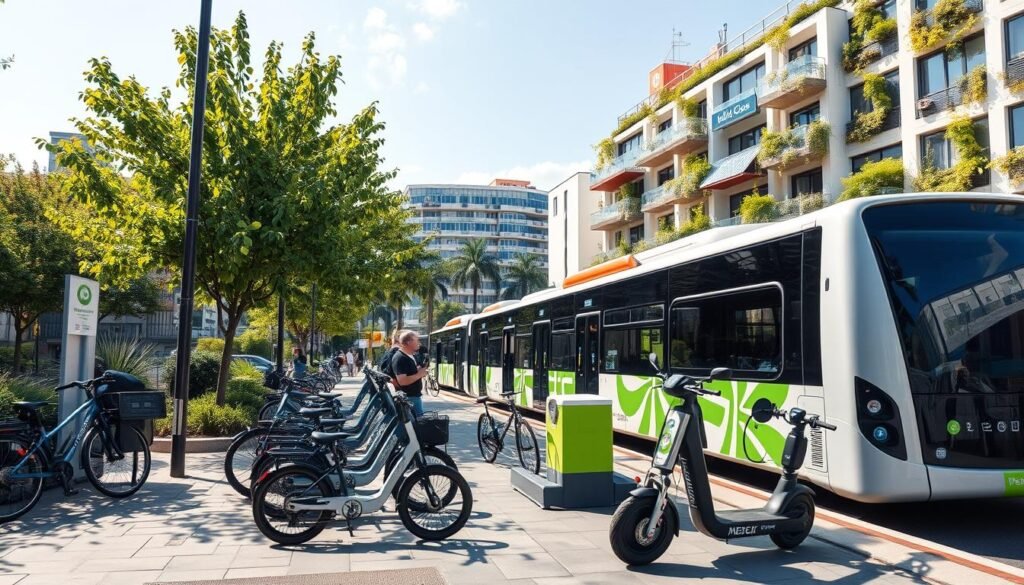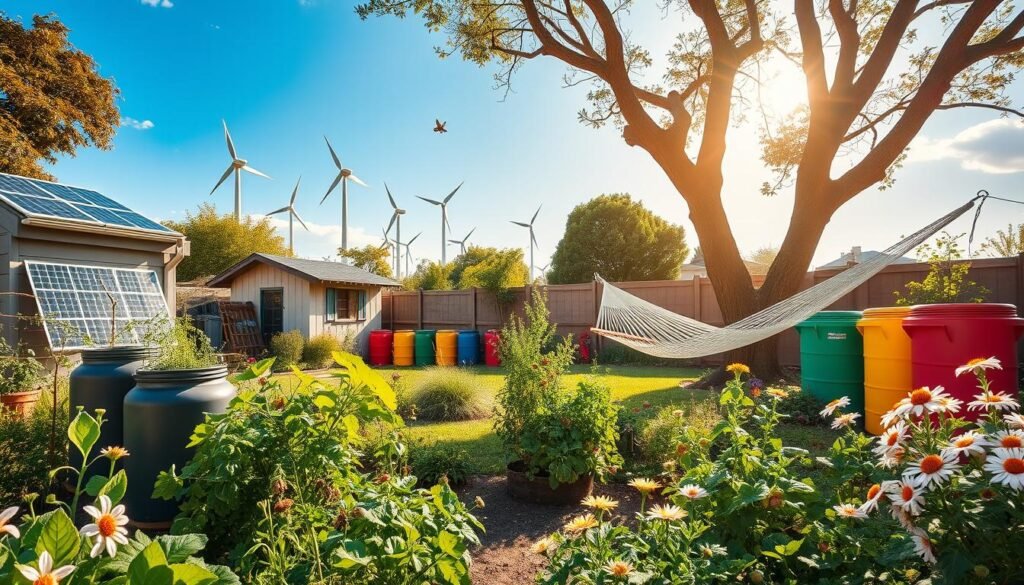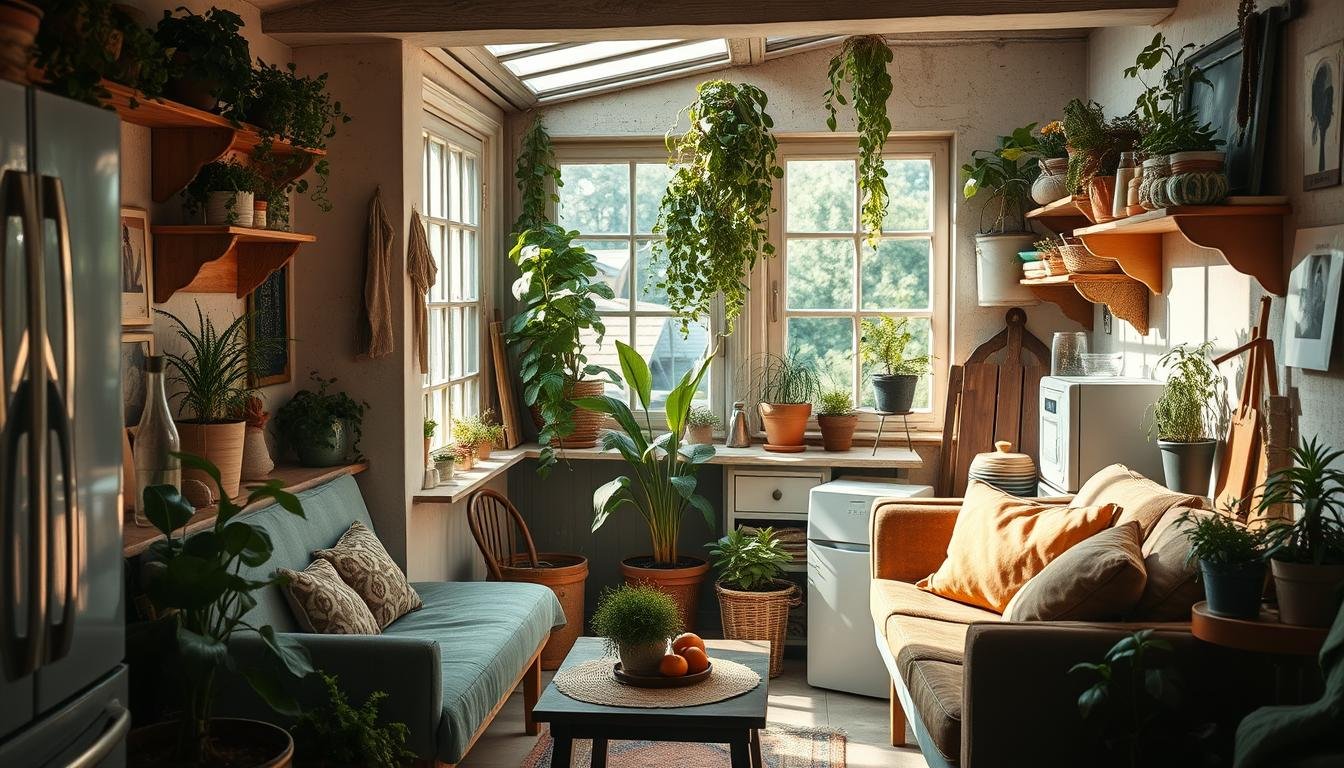Starting my journey to live sustainably, I found it’s easy to save money. Simple habits like using energy-efficient bulbs and turning off electronics help. These actions cut down on waste and save cash.
Using public transport and reducing waste also helps. These changes are good for both your wallet and the planet.
Making small changes can make a big difference. Growing your own veggies and using reusable items like fabric rags save money. These steps help you live green and save green.
Key Takeaways
- Save money by adopting sustainable living practices, such as using energy-efficient light bulbs and turning off electronics when not in use.
- Reduce waste by using reusable products, like fabric rags and reusable water bottles, to minimize environmental impact and save money.
- Use public transportation to reduce fuel consumption and lower expenses related to fuel and maintenance costs.
- Use eco-friendly budgeting practices, such as buying in bulk and using DIY cleaning supplies, to cut household costs.
- Adopt sustainable living tips, such as composting and minimizing garbage creation, to reduce waste and save money.
- Consider using solar panels to reduce energy consumption and promote long-term savings and sustainability.
- Use natural light to reduce energy usage for lighting by up to 30% during the daytime.
My Journey to Saving Money While Living Sustainably
I started my journey to live frugally and sustainably to cut down on waste and save money. I began by using less energy and taking public transport. Changing my habits was tough, but I was set on making a difference.
I made big changes in my life to save money and the planet. I switched to reusable towels instead of paper ones. I also planned my meals better to avoid food waste. This helped me save a lot, as food waste can be up to 40% of what we buy.
Some key changes I made include:
- Lowering my thermostat to save on heating and energy
- Sharing groceries with friends to cut down on packaging and costs
- Doing regular maintenance to make things last longer
These changes helped me save a lot of money and reduce waste. I saved about $9,000 a year by living sustainably. I also saved around $3,500 by shopping secondhand and $2,600 by cooking with what I already have.
Simple Energy-Saving Modifications for Your Home
Living sustainably on a budget is easy with simple home changes. Using energy-efficient light bulbs, like LEDs, is a great start. They use up to 90% less energy than old bulbs.
Another smart move is to adjust your thermostat and use power strips. This helps cut down on standby power. It saves money and reduces your carbon footprint.
Here are more ways to save energy at home:
- Insulate your home to keep warm in winter and cool in summer.
- Seal air leaks to stop heat from escaping or entering.
- Upgrade to energy-saving appliances, like Energy Star ones.
- Use smart thermostats to better control your heating and cooling.
These simple steps can greatly reduce your energy use and bills. Every little change helps towards a greener lifestyle and supports your financial goals.
Smart Water Conservation Strategies That Save Money
As I explore budget-friendly sustainable living, I’ve learned about smart water saving tips. These tips help cut down water use and lower water bills. Using low-flow fixtures like showerheads and toilets is a big help.
Harvesting rainwater is another smart move. It’s great for watering plants or washing cars. Greywater reuse systems are also useful, recycling water from sinks and showers for plants and more. These eco-friendly money saving tips help save money and protect our planet.
Some smart water saving ideas include:
- Installing low-flow showerheads, which use no more than 2 gallons of water per minute
- Implementing rainwater harvesting systems, which can capture and save approximately 1,300 gallons per year
- Using greywater reuse systems, which can recycle about 40-80 gallons of water a day
By using these strategies, we can live more sustainably and help the environment.
| Water Conservation Strategy | Water Savings |
|---|---|
| Low-flow showerheads | Up to 2.5 gallons per minute |
| Rainwater harvesting systems | Approximately 1,300 gallons per year |
| Greywater reuse systems | About 40-80 gallons per day |
Budget-Friendly Sustainable Food Practices
Living green doesn’t have to cost a lot. Making smart food choices is a big part of it. Planning meals and making a grocery list helps cut down on waste. This saves money and helps the planet.
Buying local produce is a great way to save. It’s 20-30% cheaper than out-of-season fruits and veggies. Eating less meat, like on Meatless Monday, can also save about $16 a month. Choosing whole foods over processed snacks can be cheaper too.
- Bulk buying grains, nuts, and dried fruits can save up to 50%.
- CSA boxes offer 20 pounds of local, organic produce for about $25.
- Cooking at home can save up to $300 a month compared to eating out.
By using these budget-friendly tips, we can make a big difference. We can reduce our environmental impact and save money at the same time.
Zero-Waste Living: Reducing Expenses Through Minimalism
Living zero-waste can save money and help the environment. Using reusable bags and containers is a great start. For example, reusable bags are perfect for grocery shopping. And containers are great for storing food and other items.
Reducing paper waste and avoiding single-use plastics are also smart moves. Switching to digital documents cuts down on paper. Choosing stainless steel over plastics helps too. Composting food scraps also reduces landfill waste. The average American gets about 41 pounds of junk mail a year, adding to waste.
Living simply can cut expenses by 20-50%. Buying in bulk and avoiding processed foods are good ideas. Repairing items instead of buying new ones is another way to save. For instance, high-quality clothing lasts longer than fast fashion, saving money in the long run. These steps can greatly reduce waste and save money.
Sustainable Transportation Choices That Cut Costs
My journey to adopt thrifty sustainability practices has shown me how big of an impact transportation has. It affects both our environment and our wallets. Simple changes in our daily commute can help us save money and reduce our carbon footprint.
Using public transport or carpooling can save a lot of money. It cuts down on fuel use and lowers costs. These changes are good for our planet and our pockets.
Some benefits of sustainable transport include:
- Less fuel used and lower emissions
- Lower costs for fuel and vehicle upkeep
- Better air quality and health
- More energy security and less dependence on others
The U.S. Department of Energy says using fuel-efficient cars can save up to 50% on fuel. Using alternative fuels could also cut U.S. transportation emissions by 14% by 2030. Choosing electric or hybrid cars can save money and help the environment.

By choosing better transport options, we help the planet and save money. The Office of Energy Efficiency and Renewable Energy (EERE) is working on new, green transport solutions. This means even more ways to save money and protect the environment in the future.
Eco-Friendly Shopping Habits That Save Money
My journey in thrifty sustainable living has shown me many ways to save money. One key way is adopting eco-friendly shopping habits. These habits help reduce waste and save cash.
Buying in bulk and shopping second-hand are great practices. They cut down on waste and save money. For instance, a reusable grocery bag can replace over 22,000 plastic bags, helping our planet.
Bulk Buying Strategies
Bulk buying cuts down on packaging waste and saves money. Buying nuts, grains, and cleaning supplies in bulk is good for the planet and your wallet. Also, shopping at local farmers’ markets or joining a CSA program supports local farmers and gets you fresh produce.
Second-Hand Shopping Tips
Shopping second-hand is another smart move. Thrift stores, consignment shops, and online marketplaces offer great deals on used items. It’s good for the planet and your wallet.
| Shopping Habit | Environmental Impact | Cost Savings |
|---|---|---|
| Bulk Buying | Reduces packaging waste | Saves money on individual items |
| Second-Hand Shopping | Reduces waste and supports sustainable consumption | Finds gently used items at a lower cost |
| Seasonal Shopping | Supports local farmers and reduces transportation emissions | Saves money on produce and supports the local economy |
By adopting these eco-friendly shopping habits, we can make a big difference. Whether it’s buying in bulk, shopping second-hand, or choosing seasonal produce, there are many ways to live sustainably and save money.
Creating Passive Income Through Sustainable Practices
I’ve found a way to make money while living green. By using solar panels, I cut down on energy use and earn money. This is just one way to save money and help the planet.
Other ways to make money include selling eco-friendly items like reusable bags and natural soaps. These can be made at home, saving money. You can also invest in renewable energy like wind or hydro power.
Here are some ways to create passive income through sustainable practices:
- Investing in solar panels or other renewable energy sources
- Selling homemade eco-products, such as reusable bags or natural soaps
- Participating in community solar projects or investing in green stocks and mutual funds

By using these green tips, you can make money and help the planet. It’s a great way to earn while making the world a better place.
| Sustainable Practice | Passive Income Potential |
|---|---|
| Investing in solar panels | 10-20% annual return |
| Selling homemade eco-products | $100-$1,000 per month |
| Participating in community solar projects | 5-10% annual return |
Building a Sustainable Home Garden on a Budget
Creating a sustainable home garden on a budget is easy with eco-friendly money management and simple habits. By using sustainable living on a budget methods, you can lower your environmental impact and save money. One key strategy is to reduce waste and save water.
Here are some ways to build a budget-friendly sustainable garden:
- Use recycled materials for containers and garden beds
- Install efficient irrigation systems to cut down water use
- Compost kitchen scraps to make nutrient-rich soil and reduce waste
- Apply mulch to lessen watering needs and weed growth
Also, save money by joining community seed swaps, buying mulch in bulk, and going to local plant sales. These eco-friendly money management tips help you grow a green garden without breaking the bank.
By using sustainable living on a budget and green financial strategies daily, you can positively impact the environment and save cash. This gardening approach benefits you and helps create a greener future.
| Technique | Cost Savings |
|---|---|
| Using recycled materials | Up to 50% on gardening costs |
| Composting kitchen scraps | Approximately $100 to $200 annually on fertilizers |
| Implementing rainwater harvesting system | About 40% off water bills |
Conclusion: Embracing a Green Future While Protecting Your Wallet
Adopting sustainable living tips and frugal green living practices can really help your finances. Simple changes in our daily lives can cut down on waste and save money. This way, we can help the planet and our wallets at the same time.
Using energy-efficient lightbulbs can save up to 75% on lighting costs. Water-saving showerheads can also cut down on water bills by hundreds of dollars each year. Buying seasonal produce and shopping at local farmers’ markets are other ways to save money while being eco-friendly.
Living sustainably can also save you money. By making these changes, we can protect the environment and our finances. It’s all about taking small steps today to create a better future for everyone.


Leave a Reply